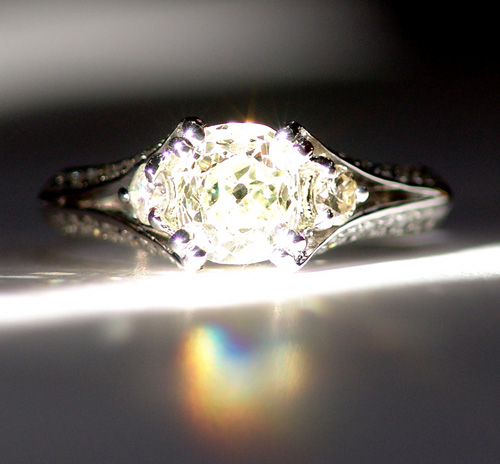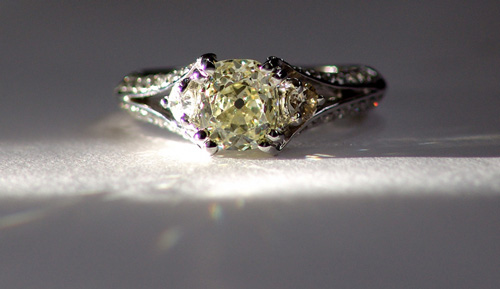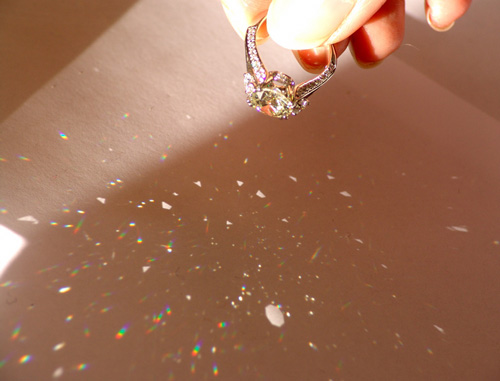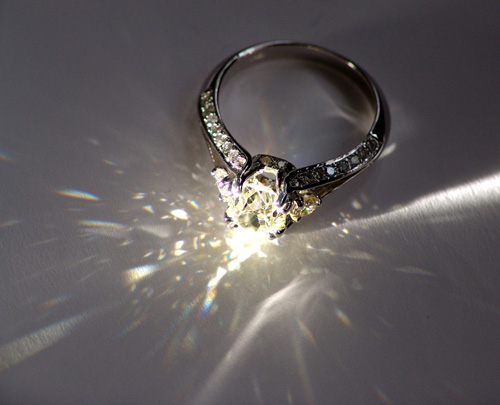
A light yellow, old cushion cut diamond with a large culet, weighing ca. 1.9 cts.
When I first got interested in diamonds, I started like everyone else on the 5Cs of a diamond – its cut, clarity, colour, carat weight and certificate.
Questions like, which of these Cs are more important if you’re working on a budget was also part of the learning process and a practical question to consider when buying a diamond. And for the longest time, I could not weigh the importance of either of the Cs with each other. I wanted all of them in my stone ranked as high as possible, meaning I wanted best colour, best cut, best clarity, biggest carat and most definitely certified, in the budget!
So I went to a jeweler and specified what I wanted. I got myself a half-carat, GIA certified, E colour, excellent cut, excellent clarity VS1 diamond. I had it set in a nice ring and was really proud of it for all about three months. While the stone scored excellent grades on the GIA certificate it failed to excite me or make happy when I looked at it. I always think that one should light up like a Christmas tree when looking at a diamond, because that’s what diamonds naturally do – the prism of colours that burst out of a diamond signals a rainbow of opportunities even in your darkest times. Even if a diamond can never erase your problems, it can at least give you a sense of hope when looking at it. For one thing, you could always sell it for cash, if lack of funds is a problem.
But this half-carat E colour VS1 stone was not doing that for me. Rather, it looked like a cracked ice cube sitting on my finger. I couldn’t figure out why. The light, rather than bounce off through the stone in a prism of colours, seemed to rather stop short of giving full force brilliance.
I finally made up my mind and sold that half-carat diamond ring at a painful loss after one year of having it. And what I’ve learnt, expensively, was that certificates don’t really matter when it comes to whether a stone looks good or not. Nobody ever asked to see the stone’s certificate whilst I had it on my finger – most people if anything asked about its size and colour.
So what I should’ve done when buying my first diamond was to trust my own eyes, to trust my instincts. It’s been several years now for me, looking at many many diamonds that have come my way where I can handle them and peer at them through a loupe. And I think I constantly go back to my own senses and instincts if I should consider buying stones.

Despite what a certificate might say, excellent cut, excellent polish and symmetry etc., the questions that I constantly ask myself are – will this stone make me happy whenever I look at it? Does it speak to me and does it want to belong to me? If the answer is yes, then I’d go for it. If the answer is no, then it doesn’t matter the certificate, the size, the clarity or the cut. The stone will never make you happy anyway.
The pictures in this post feature the 1.90 ct light yellow, old cut stone with a fairly large culet. The colour of the stone does not, in my view, affect its brilliance. The cutting is important, so is the clarity, as inclusions might detract the reflection of light within the stone and out of the stone as you can see in the picture below.

On my part, I could live with minor inclusions if that enables me to recognize my stone. I view inclusions like birthmarks and identity tags to a stone that makes it unique and recognisable to me or anyone else.
This light yellow diamond ring, is flanked on either side with two modern brilliant cut diamonds. With its light yellow colour and old cut, but fairly good clarity at VS2, I’d say this stone does a heck of a job at light play.
Any wearer would be proud of this stone.

On a related note, Dagens nyheter has reported findnings of the worlds largest diamond rough! Have a read and enjoy!